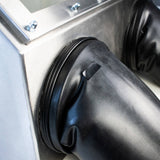Air Free Techniques

Air free techniques are essential for the handling and storage of materials that are unstable when exposed to air. Compounds are defined as unstable if they react with an element in air, often moisture or oxygen. However, materials that react with nitrogen or CO2 are also air sensitive, although this is less common. These air-based reactions may take place under normal ambient conditions or could be activated by high temperatures or light illumination.
To ensure the safe handling and storage of these materials, you will likely need specialist equipment such as a glove box, glove bag, or a Schlenk line. There are also common methods and practises used with air free techniques to keep air separate from these environments. This article will discuss some examples of air-sensitive compounds. We also describe and compare air free techniques and share our knowledge about how and when to use them.
Air Free Techniques
It is essential that you take the necessary precautions when you are working with air sensitive samples. When choosing an appropriate method for your air-sensitive experiments, factors to consider include the frequency of use of air sensitive materials, the stability of those materials, the type of work you are doing, and the complexity of the system needed for this. Such air free techniques are essential for successful and safe experimentation.

Glove Boxes
One of the most secure ways to create and sustain an air free environment, glove boxes are usually made of impermeable materials, such as stainless steel, and have in-built circulation or drying mechanisms to maintain low O2 and H2O levels. When connected to a consistent inert gas supply, these systems can support an air-free environment for extended periods of time. This creates a safe environment where you can open, decant, handle, and process air sensitive materials with no risk of exposure to air.
Designed to create a relatively large amount of inert space, they can be used like a normal work bench. Of the air free techniques, this makes them the easiest to work in. This also gives you maximum adaptability as you can set up various equipment in the main chamber, such as spin coaters, hot plates, modular UV-Vis spectrometers, and more. However, space within a glove box will always be limited and, therefore, the complexity of reactions that they can accommodate is also limited.
Schlenk Lines
Schlenk lines are popular choices for doing chemical synthesis or chemical reactions in an inert environment. One side of a glass tube is connected to an inert gas source, and the other to a vacuum pump. There are several ports along this tube to which you can connect the glassware required for a given reaction. You can select the inert gas supply or the vacuum pump to be exposed to the Schlenk line using specialist stopcocks or valves.
The primary advantage of a Schlenk line is that they provide a highly controlled atmosphere for air-sensitive compounds. It also utilizes a gas manifold, which can be adjusted to provide an atmosphere of nitrogen, argon, or a combination of both. This allows you to make precise adjustments to the atmosphere within the system. Schlenk lines therefore provide a higher degree of control than a glove box can. Schlenk lines also give you the ability to transfer materials between two lines quickly and easily. However, Schlenk lines are expensive to assemble and require specialist equipment. Additionally, this high level of control is not needed for simple processes such as decanting or storing materials. These systems are designed specifically for conducting chemical reactions so will not be appropriate for other uses, such as fabricating or characterising thin film samples.
For complex chemical synthesis, such as synthesizing multiple air-sensitive compounds, a Schlenk line may be the appropriate air free technique.
Glove bags
Glove bags are single-use, disposable enclosures. They are usually made from transparent polymer materials such as polyethylene. Glove bags are portable and create short term inert environments that can be assembled quickly and easily. These are good for short term experiments or if you occasionally need to prepare samples or materials in an inert environment before sealing and bringing into ambient conditions.
Glove bags are relatively inexpensive compared to the previously defined processing techniques. However, they are harder to purge than traditional glove boxes and more easily compromised - so the inert environment they create is not very secure. These are therefore suitable for use in short-term, infrequent inert processing where contamination control is not the highest priority.
Removing Materials from Air Free Environments
If you need to take an air-sensitive material out of an inert environment, you can seal the material in a sealed container before taking into air. This should protect the material from being exposed to moisture or oxygen and will keep your material intact. Here are some examples of ways in which you can enclose materials:
- You can seal powders or solutions in glass vials (these can also be sealed/stored in amber vials if they are light sensitive too).
- Materials and samples can also be sealed in vacuum bags using a household vacuum sealer.
- In a pinch, you can also seal materials or samples within resealable plastic bags. Please note that you should only use these less secure techniques with materials that degrade in air, not with materials that are hazardous to health.
Glove Box

Learn More
 Glove Box Leaks
Glove Box Leaks
The most common cause of a leak is human error, either as a result of not following operating procedures correctly or from accidental damage.
Read more... Glove Box Design
Glove Box Design
There are several important components to consider when designing a glove box.
Read more...